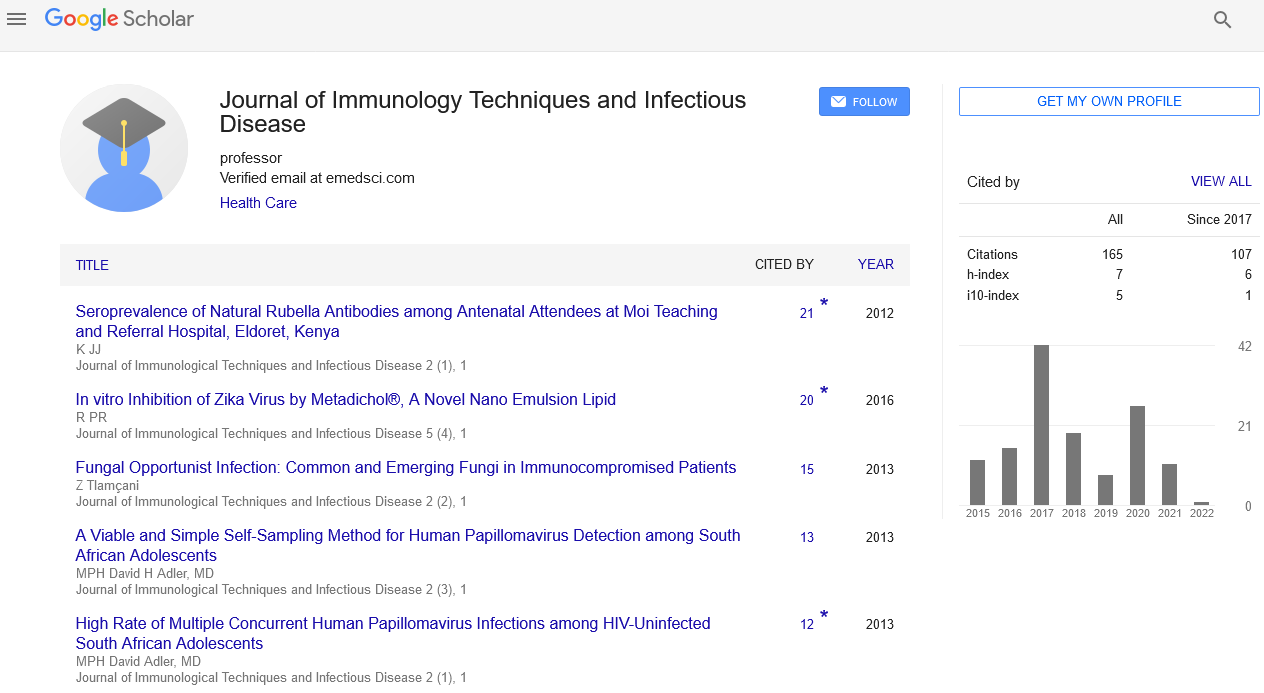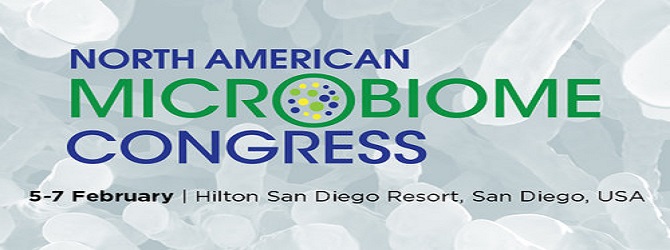Commentary, J Immunol Tech Infect Dis Vol: 11 Issue: 1
Incidental Detection of Parasites: A Pathologists Viewpoint
Martyn French*
Department of Immunology and Microbiology, Monash University, Melbourne, Australia
*Corresponding author: Martyn French
Department of Immunology and Microbiology, Monash University, Melbourne, Australia
Email: martyn.french@uwa.edu.au
Received date: 03 January, 2022; Manuscript No: JIDIT-22-57178;
Editor assigned date: 06 January, 2022; PreQC No. JIDIT-22-57178(PQ);
Reviewed date: 16 January, 2022, QC No: JIDIT-22-57178;
Revised date: 28 January, 2022, Manuscript No. JIDIT-22-57178(R);
Published date: 3 February, 2022, DOI: 10.4172/ 2329-9541.1000182.
Abstract
In biology, immunity is the capability of multicellular organisms to resist harmful microorganisms. Immunity involves both specific and nonspecific components. The nonspecific components act as barriers or eliminators of a wide range of pathogens irrespective of their antigenic make-up [1]. Other components of the immune system adapt themselves to each new disease encountered and can generate pathogen-specific immunity. Immunity is a complex biological system that can recognize and tolerate whatever belongs to the self, and to recognize and reject what is foreign non-self. The immune system has innate and adaptive components. Innate immunity is present in all metazoans, while adaptive immunity only occurs in vertebrates [2]. The innate component of the immunity system involves the recognition of certain foreign non-self-molecules to generate one of two types of innate immune responses: Inflammatory responses and phagocytosis. The adaptive component, on the other hand, involves more advanced lymphatic cells that can distinguish between specific non-self-substances in the presence of self. The reaction to foreign substances is etymologically described as inflammation while the non-reaction to self-substances is described as immunity. The two components of the immune system create a dynamic biological environment where health can be seen as a physical state where the self is immunologically spared, and what is foreign is inflammatorily and immunologically eliminated. Disease can arise when what is foreign cannot be eliminated or what is self is not spared
Keywords: Immunology and Microbiology
In biology, immunity is the capability of multicellular organisms to resist harmful microorganisms. Immunity involves both specific and nonspecific components. The nonspecific components act as barriers or eliminators of a wide range of pathogens irrespective of their antigenic make-up end. Other components of the immune system adapt themselves to each new disease encountered and can generate pathogen-specific immunity. Immunity is a complex biological system that can recognize and tolerate whatever belongs to the self, and to recognize and reject what is foreign non-self. The immune system has innate and adaptive components. Innate immunity is present in all metazoans, while adaptive immunity only occurs in vertebrates right. The innate component of the immunity system involves the recognition of certain foreign non-self-molecules to generate one of two types of innate immune responses: Inflammatory responses and phagocytosis. The adaptive component, on the other hand, involves more advanced lymphatic cells that can distinguish between specific non-self-substances in the presence of self. The reaction to foreign substances is etymologically described as inflammation while the nonreaction to self-substances is described as immunity. The two components of the immune system create a dynamic biological environment where health can be seen as a physical state where the self is immunologically spared, and what is foreign is inflammatorily and immunologically eliminated. Disease can arise when what is foreign cannot be eliminated or what is self is not spared. Innate immunity, also known as native immunity is a semi-specific and widely distributed form of immunity. It is defined as the first line of defense against pathogens representing a critical systemic response to prevent infection and maintain homeostasis, contributing to the activation of an adaptive immune response. It does not adapt to make specific external stimulus or a prior infection, but relies on genetically encoded recognition of particular patterns. Adaptive or acquired immunity is the active component of the host immune response, mediated by antigen-specific lymphocytes. Unlike the innate immunity, the acquired immunity is highly specific to a particular pathogen, including the development of immunological memory int. Like the innate system, the acquired system includes both humoral immunity components and cell-mediated immunity components. Adaptive immunity can be acquired either naturally by infection or artificially through deliberate actions such as vaccination. Adaptive immunity can also be classified as active or passive. Active immunity is acquired through the exposure to a pathogen, which triggers the production of antibodies by the immune system. Passive immunity is acquired through the transfer of antibodies or activated T-cells derived from an immune host either artificially or through the placenta; it is short-lived, requiring booster doses for continued immunity.
History of Theories
For thousands of years mankind has been intrigued with the causes of disease and the concept of immunity. The prehistoric view was that disease was caused by supernatural forces, and that illness was a form of theurgic punishment for bad deeds or evil thoughts visited upon the soul by the gods or by one's enemies farinded. In Classical Greek times, Hippocrates, who is regarded as the Father of Medicine, diseases were attributed to an alteration or imbalance in one of the four humors blood, phlegm, yellow bile or black bile. The first written descriptions of the concept of immunity may have been made by the Athenian Thucydides who in 430 BC, described that when the plague hit Athens: The sick and the dying were tended by the pitying care of those who had recovered, because they knew the course of the disease and were themselves free from apprehensions. For no one was ever attacked a second time, or not with a fatal result. Active immunotherapy may have begun with mithridates VI of Pontus (120-63 BC) who, to induce active immunity for snake venom, recommended using a method similar to modern toxoid serum therapy, by drinking the blood of animals which fed on venomous snakes. He is thought to have assumed that those animals acquired some detoxifying property, so that their blood would contain transformed components of the snake venom that could induce resistance to it instead of exerting a toxic effect. Mithridates reasoned that by drinking the blood of these animals, he could acquire a similar resistance. Fearing assassination by poison, he took daily sub-lethal doses of venom to build tolerance. He is also said to have sought to create a universal antidote to protect him from all poisons.
Passive Immunity
Passive immunity is the immunity acquired by the transfer of readymade antibodies from one individual to another. Passive immunity can occur naturally, such as when maternal antibodies are transferred to the foetus through the placenta, and can also be induced artificially, when high levels of human or horse antibodies specific for a pathogen or toxin are transferred to non-immune individuals. Passive immunization is used when there is a high risk of infection and insufficient time for the body to develop its own immune response, or to reduce the symptoms of ongoing or immunosuppressive diseases. Passive immunity provides immediate protection, but the body does not develop memory therefore the patient is at risk of being infected by the same pathogen later. A fetus naturally acquires passive immunity from its mother during pregnancy. Maternal passive immunity is antibody-mediated immunity valus. The Mother’s Antibodies (MatAb) are passed through the placenta to the fetus by an FcRn receptor on placental cells. This occurs around the third month of gestation. IgG is the only antibody is a type that can pass through the placenta. Passive immunity is also provided through the transfer of IgA antibodies found in breast milk that are transferred to the gut of a nursing infant, protecting against bacterial infections, until the newborn can synthesize its antibodies. Colostrum present in mothers milk is an example of passive immunity. Artificially acquired passive
 Spanish
Spanish  Chinese
Chinese  Russian
Russian  German
German  French
French  Japanese
Japanese  Portuguese
Portuguese  Hindi
Hindi 
